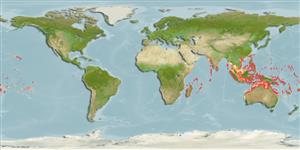>
Lophiiformes (Anglerfishes) >
Antennariidae (Frogfishes)
Etymology: Antennatus: From Latin, antenna, antemna = sensory organ, that has got antennae (Ref. 45335).
More on author: Cuvier.
Environment: milieu / climate zone / Tiefenbereich / distribution range
Ökologie
seewasser riff-verbunden; tiefenbereich 0 - 73 m (Ref. 6773), usually 0 - 10 m (Ref. 90102). Tropical; 25°N - 35°S, 29°E - 140°W (Ref. 57379)
Indo-Pacific: East Africa (but apparently absent north of the Chagos Archipelago) to the Philippines and the Moluccas and eastward to island groups of the Pacific Plate.
Size / Gewicht / Alter
Geschlechtsreife: Lm ? range ? - ? cm
Max length : 9.0 cm SL Männchen/unbestimmt; (Ref. 54980)
Rückenflossenstacheln (insgesamt) : 3; Rückenflossenweichstrahlen (insgesamt) : 12; Afterflossenstacheln: 0; Afterflossenweichstrahlen: 7 - 8. Illicium slightly longer than 2nd dorsal spine tapering to a non-filamentous simple tentacle that lacks an esca. Lacks a groove between the upper jaw and base of the illicium. Distinctive color pattern in which there is a broad dark band and marginal dark bands on the anal and caudal fins.
Body shape (shape guide): short and / or deep; Cross section: compressed.
Benthic species (Ref. 58302, 75154) found in inshore coral reef (Ref. 75154). The average depth for all known captures was 11.2 m. Individuals maintained in experimental aquaria change in color from dark gray to light cream within 2 weeks. Oviparous. Eggs are bound in ribbon-like sheath or mass of gelatinous mucus called 'egg raft' or 'veil' (Ref. 6773). Solitary and sometimes among hard coral branches (Ref 90102).
Life cycle and mating behavior
Geschlechtsreife | Fortpflanzung | Ablaichen | Eier | Fecundity | Larven
Oviparous. Eggs are bound in ribbon-like sheath or mass of gelatinous mucus called 'egg raft' or 'veil' (Ref. 6773).
Pietsch, T.W. and D.B. Grobecker, 1987. Frogfishes of the world. Systematics, zoogeography, and behavioral ecology. Stanford University Press, Stanford, California. 420 p. (Ref. 6773)
IUCN Rote Liste Status (Ref. 130435: Version 2025-1)
Bedrohung für Menschen
Poisonous to eat
Nutzung durch Menschen
Fischereien: nicht kommerziell
Tools
Zusatzinformationen
Download XML
Internet Quellen
Estimates based on models
Preferred temperature (Ref.
123201): 25 - 29.3, mean 28.2 °C (based on 2427 cells).
Phylogenetic diversity index (Ref.
82804): PD
50 = 0.5625 [Uniqueness, from 0.5 = low to 2.0 = high].
Bayesian length-weight: a=0.02630 (0.01029 - 0.06725), b=2.96 (2.73 - 3.19), in cm total length, based on LWR estimates for this (Sub)family-body shape (Ref.
93245).
Trophic level (Ref.
69278): 3.8 ±0.7 se; based on size and trophs of closest relatives
Widerstandsfähigkeit (Ref.
120179): hoch, Verdopplung der Population dauert weniger als 15 Monate. (Fec assumed to be > 10,000).
Fishing Vulnerability (Ref.
59153): Low vulnerability (10 of 100).
🛈
Nutrients (Ref.
124155): Calcium = 79.3 [34.8, 153.3] mg/100g; Iron = 0.686 [0.339, 1.315] mg/100g; Protein = 18.6 [16.0, 21.8] %; Omega3 = 0.137 [0.048, 0.355] g/100g; Selenium = 21.2 [8.2, 56.3] μg/100g; VitaminA = 326 [73, 1,416] μg/100g; Zinc = 1.28 [0.76, 2.11] mg/100g (wet weight);
